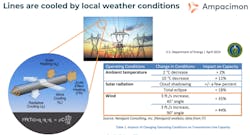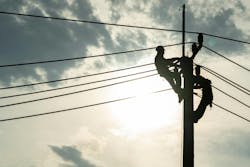To guarantee the tensile strength and clearance requirements of transmission lines are not violated under time-varying external conditions, transmission lines are given line ratings that determine their maximum power-carrying capacities. Many utilities determine line ratings using approaches such as seasonal or static ratings. However, dynamic line ratings (DLRs) are rising in popularity as an innovative approach to evaluating the capacity of transmission lines by considering real-time weather conditions.
Unlike static or seasonal ratings, which assume conservative values, DLRs consider real-time, specific environmental factors such as temperature, solar radiation and, most importantly, wind. By incorporating these variables, DLRs offer the potential for increased line capacity and reduced risk of transmission failures. Spurred by the move to renewable energy generation and vastly different loads on the grid like electric vehicles, data centers and even cryptocurrency mines, the need for increased capacity and reduced risk of failures has never been greater.
The WATT Coalition estimates about 30% of grid congestion can be addressed using grid-enhancing technologies (GETs). DLRs are one such GET. Here is a look at how to properly implement them to ensure accurate ratings assessments.
Traditional Line Ratings
Various types of line capacity ratings exist, ranging from static to dynamic approaches. Static ratings are based on a worst-case scenario, assuming high temperatures and little consideration for weather variables. Seasonal ratings adjust the capacity based on different anticipated weather conditions during specific seasons. For instance, electrical resistance typically decreases with decreasing temperature, meaning at colder temperatures more power can be pushed through conductors. Increases in ambient air temperatures tend to increase a transmission line's operating temperature and lower a transmission line's rating, while lower ambient air temperatures tend to lower a transmission line's operating temperature and increase the transmission line's rating.
Overestimating the line assumptions can lead to inaccurate line ratings, which can have disastrous consequences. Overloading a transmission line can lead to sags, clearance issues and, ultimately, faults, posing a threat to the stability of the entire grid. Major blackouts in the past, such as the infamous 2003 Northeast blackout were partly caused by improperly rated lines that exceeded their capacity and led to catastrophic failures. Implementing modern DLRs enables utilities to get a more comprehensive and real-time evaluation of line capacity by incorporating weather forecasts and actual live sensor measurements, thereby reducing the risk of failures and ensuring grid reliability.
More Precise Weather Variables
While obtaining weather data from providers may seem straightforward, the challenge lies in the localization and accuracy of the information. Weather providers typically have stations only in main towns, and their models fill in the gaps using topographical data. For ambient temperature, which does not vary significantly over tens of miles, these weather models are adequate. Hence, why FERC Order 881 is possible and a useful development.
However, accurately modeling wind is a different beast. Modeling wind conditions becomes increasingly complicated when considering factors such as changes in terrain, obstacles like trees and buildings, and height variations. Consequently, obtaining precise wind data requires placing sensors either directly on or near transmission lines. Some solutions can measure wind with a sensor on a line, while others do so by adding weather stations on the tower. Although both options are viable, pricing and maintenance requirements increase with weather stations on towers.
When it comes to line capacity, weather variables play a crucial role. Ambient temperature changes of just a few degrees Celsius can result in a percentage change in capacity — 1% per 1.8°F change in ambient temperature — while solar radiation variations can also impact capacity by up to 18%. However, wind speed and direction are the most influential factors. Just a 3-fps (0.9-mps) increase in wind speed, similar to a person’s walking speed, can lead to a 44% increase in capacity. Therefore, accurately measuring wind conditions becomes critical to effectively implementing DLRs.
By Brian Berry, Ampacimon
All line ratings are a delicate balance between risk and opportunity. Even static and seasonal ratings make assumptions on the worst-case weather. DLR enables utilities to measure with precision rather than assumptions. With wind-enabled DLRs in place, engineers have better visibility and can more accurately and actively monitor real-time weather conditions. This means a DLR-monitored line’s rating may drop initially compared to the broad general estimate that would have been applied in the past. However, after that initial dip, engineers can precisely calculate the line rating based on much more accurate factors, including wind speed, temperature extremes and solar radiation. This approach provides a more exact portrayal of a transmission line's capacity and potential risks. Real-time seasonal adjustments further refine the rating, ensuring it reflects the nuanced changing conditions throughout the year.
DLR Benefits
DLRs offer significant benefits over traditional static ratings, seasonal line ratings and even ambient adjusted ratings as mandated by FERC Order 881. With DLRs, it is possible to achieve up to 40% capacity gains by accurately measuring real-time weather conditions. In comparison, relying solely on weather data from providers may result in smaller gains because of the conservative nature of their information. DLRs provide a more precise evaluation, mitigating the risks — like faults, wildfires and blackouts — associated with using weather data alone.
DLRs represent a significant advancement in accurately assessing the capacity of transmission lines. By incorporating real-time weather data, DLRs offer the potential for substantially increased capacity gains while reducing the risk of transmission failures. While the initial ratings dips from implementing DLRs should not be underestimated, the benefits are undeniable. Embracing DLRs will be crucial to achieve a green and renewable grid by enabling more capacity at significantly lower cost and time — thereby ensuring a reliable and resilient grid into the future.
Brian Berry is chief product officer for Ampacimon. He has more than 14 years of experience in the energy market, including expertise in electrical engineering, power systems operations, product management, power system stability, modeling and simulation, wide area monitoring and control systems, signal processing and synchrophasor technology.
About the Author
Brian Berry
Brian Berry is chief product officer for Ampacimon. He has more than 14 years of experience in the energy market, including expertise in electrical engineering, power systems operations, product management, power system stability, modeling and simulation, wide area monitoring and control systems, signal processing and synchrophasor technology.


